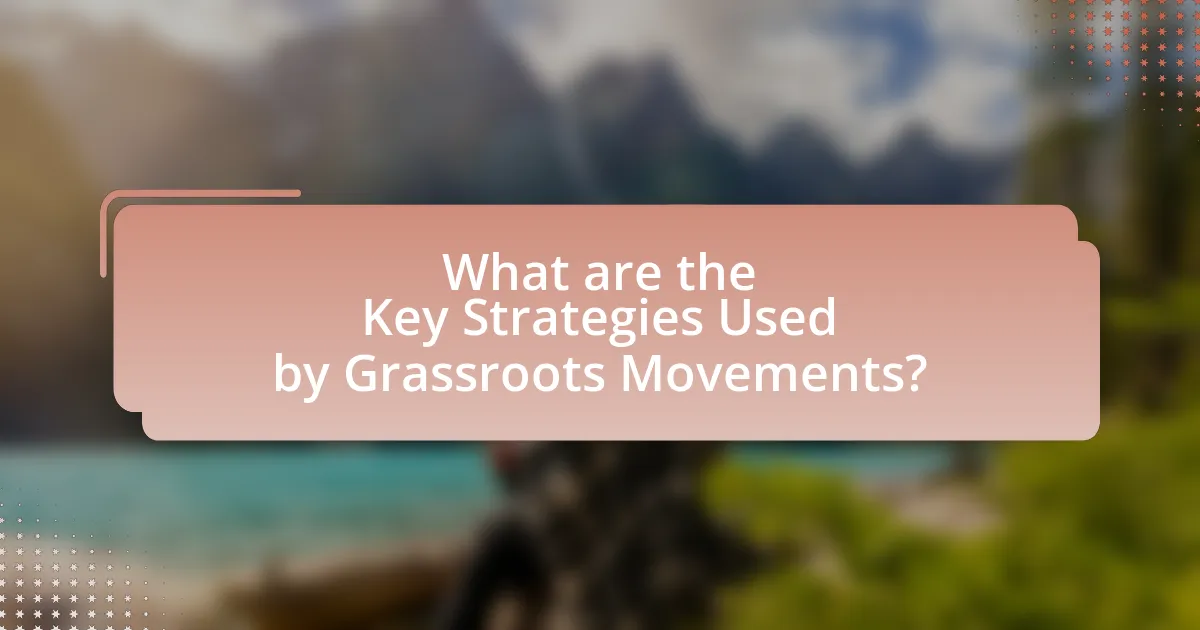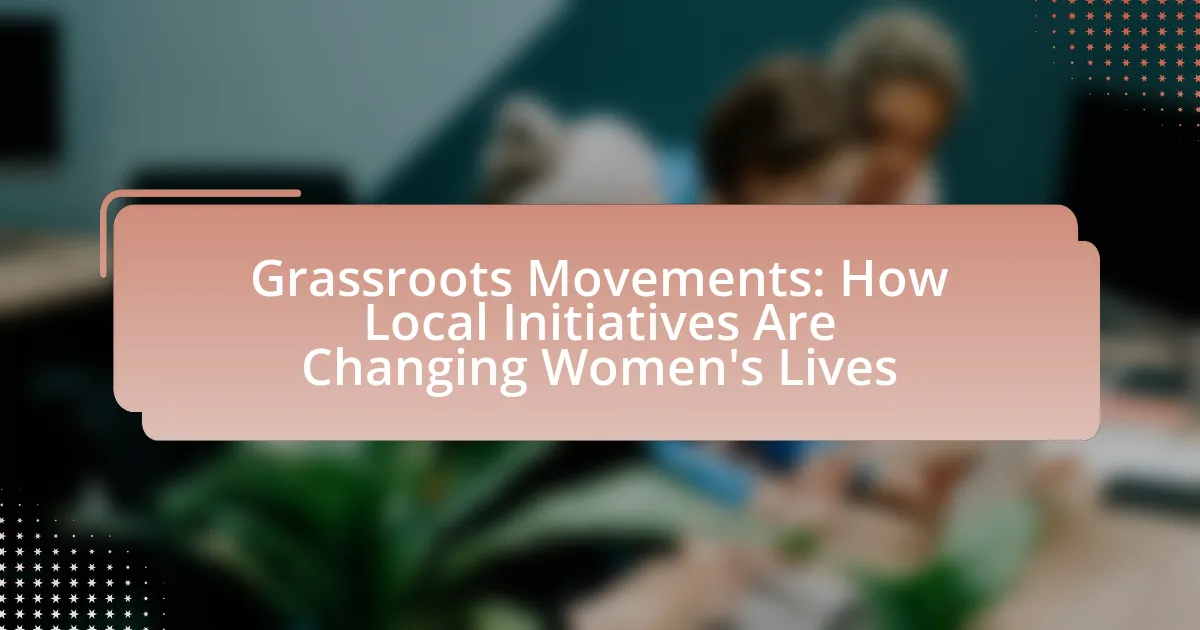Grassroots movements are community-led initiatives aimed at addressing social, political, and economic issues, particularly for marginalized groups such as women. These movements empower women by providing platforms for advocacy, access to resources, and fostering community solidarity, as exemplified by initiatives like the Women’s March. The article explores how grassroots organizations enhance women’s lives through education, economic independence, and policy advocacy, while also addressing unique challenges faced by women. It highlights the importance of grassroots movements in driving social change, their historical context, and the strategies they employ to mobilize support and resources. Additionally, the article discusses emerging trends, the role of technology, and practical steps individuals can take to support these movements.
What are Grassroots Movements and Their Role in Women’s Lives?
Grassroots movements are community-led initiatives that aim to address social, political, and economic issues, often focusing on marginalized groups, including women. These movements empower women by providing a platform for their voices, advocating for their rights, and fostering community solidarity. For instance, the Women’s March, which began in 2017, mobilized millions globally to advocate for women’s rights and social justice, demonstrating the significant impact grassroots movements can have on public awareness and policy change. Additionally, research by the World Bank indicates that grassroots organizations improve women’s access to resources and decision-making processes, thereby enhancing their overall quality of life.
How do grassroots movements empower women in local communities?
Grassroots movements empower women in local communities by providing them with a platform for collective action and advocacy. These movements facilitate access to resources, education, and support networks that enhance women’s leadership skills and promote gender equality. For instance, organizations like Women for Women International have demonstrated that women participating in grassroots initiatives experience increased economic independence and improved social status within their communities. Research indicates that when women engage in grassroots activism, they not only influence local policies but also inspire other women to assert their rights, thereby creating a ripple effect of empowerment.
What specific initiatives are led by grassroots organizations to support women?
Grassroots organizations lead various initiatives to support women, including community-based education programs, microfinance schemes, and advocacy for policy changes. For instance, organizations like Women for Women International provide vocational training and financial literacy to women in conflict-affected areas, empowering them economically. Additionally, grassroots movements often focus on raising awareness about women’s rights and health issues, such as the work done by the Global Fund for Women, which funds local initiatives that address gender-based violence and promote reproductive health. These initiatives are crucial as they directly impact women’s lives by enhancing their skills, providing financial independence, and advocating for their rights in society.
How do these initiatives address the unique challenges faced by women?
These initiatives address the unique challenges faced by women by providing targeted support and resources that empower them economically, socially, and politically. For instance, grassroots movements often focus on creating access to education and vocational training specifically for women, which is crucial in regions where gender disparities in education are prevalent. According to a report by the World Bank, investing in women’s education can lead to a 10-20% increase in economic growth in developing countries. Additionally, these initiatives frequently establish networks that foster community support, enabling women to share experiences and resources, which is vital in combating social isolation and discrimination. By addressing issues such as healthcare access, legal rights, and economic opportunities, these grassroots movements effectively tackle the systemic barriers that hinder women’s progress.
Why are grassroots movements important for social change?
Grassroots movements are important for social change because they empower individuals and communities to advocate for their rights and needs. These movements often arise from local issues and mobilize collective action, leading to significant societal shifts. For instance, the Women’s March in 2017, which began as a grassroots initiative, successfully raised awareness about women’s rights and influenced policy discussions at national levels. Additionally, research from the Stanford Social Innovation Review highlights that grassroots movements can effectively challenge systemic inequalities by fostering community engagement and building networks of support.
What historical context has shaped the emergence of grassroots movements?
Grassroots movements have emerged primarily in response to social injustices and political disenfranchisement throughout history. The civil rights movement in the United States during the 1950s and 1960s exemplifies this, as marginalized communities organized to combat systemic racism and advocate for equal rights. Additionally, the women’s suffrage movement in the early 20th century highlighted the need for women’s voices in political discourse, leading to significant legislative changes. These movements were often fueled by economic disparities, such as the Great Depression, which prompted collective action among those affected. Historical events like these demonstrate how grassroots movements have been shaped by the need for social change and empowerment among underrepresented groups.
How do grassroots movements differ from traditional advocacy efforts?
Grassroots movements differ from traditional advocacy efforts primarily in their structure and approach to mobilization. Grassroots movements are typically community-driven, relying on local participation and collective action to address issues, whereas traditional advocacy efforts often involve established organizations or institutions that may operate from a top-down perspective. For example, grassroots movements like the Women’s March in 2017 emerged from local communities and utilized social media to mobilize individuals, demonstrating a decentralized approach that contrasts with traditional advocacy groups that may rely on formal lobbying and established networks. This distinction highlights how grassroots movements prioritize direct engagement and local empowerment, fostering a sense of ownership among participants.
What impact do grassroots movements have on policy and legislation?
Grassroots movements significantly influence policy and legislation by mobilizing community support and raising awareness on critical issues. These movements often lead to tangible changes, such as the enactment of laws or amendments that reflect the demands of the community. For instance, the Women’s March in 2017 galvanized millions and contributed to increased political engagement, resulting in a record number of women elected to office in subsequent elections. This demonstrates how grassroots initiatives can shift political landscapes and drive legislative change.
How do local initiatives influence broader political agendas?
Local initiatives influence broader political agendas by demonstrating grassroots support for specific issues, which can lead to policy changes at higher levels of government. For example, initiatives focused on women’s rights, such as local campaigns for equal pay or reproductive health access, often gain traction and visibility, prompting state or national lawmakers to address these issues in their legislative agendas. Research shows that successful local movements can create a ripple effect, inspiring similar initiatives in other regions and prompting political leaders to respond to constituents’ demands, as seen in the rise of the women’s march movements across various cities, which significantly impacted national discussions on gender equality.
What examples exist of successful policy changes driven by grassroots efforts?
Successful policy changes driven by grassroots efforts include the passage of the Violence Against Women Act (VAWA) in the United States in 1994, which was largely influenced by grassroots advocacy from women’s organizations. These organizations mobilized public support and lobbied Congress, resulting in significant federal funding for programs aimed at preventing domestic violence and supporting survivors. Another example is the successful campaign for marriage equality in various countries, where grassroots movements organized protests, awareness campaigns, and lobbying efforts that ultimately led to legal recognition of same-sex marriage in places like the United States in 2015. These instances demonstrate how grassroots initiatives can effectively influence policy and create lasting change.
How do grassroots movements foster community engagement?
Grassroots movements foster community engagement by empowering individuals to participate actively in local issues and initiatives. These movements often mobilize community members around shared concerns, creating a sense of ownership and responsibility. For instance, studies have shown that grassroots organizations can increase civic participation by providing platforms for dialogue and collaboration, which enhances social cohesion. According to a report by the National Civic League, communities involved in grassroots efforts experience higher levels of voter turnout and volunteerism, demonstrating the effectiveness of these movements in fostering active engagement.
What challenges do grassroots movements face in promoting women’s rights?
Grassroots movements face significant challenges in promoting women’s rights, primarily due to limited funding and resources. These movements often rely on small donations and volunteer efforts, which restrict their capacity to implement large-scale initiatives or sustain long-term campaigns. Additionally, they encounter resistance from established political and social structures that may oppose changes to the status quo, making it difficult to gain traction for their causes. For instance, a study by the United Nations Development Programme highlights that grassroots organizations often struggle to influence policy due to a lack of access to decision-makers and insufficient representation in formal political processes. Furthermore, societal norms and cultural barriers can hinder the acceptance of women’s rights initiatives, as traditional views may prioritize patriarchal structures over gender equality.
How can grassroots organizations overcome these challenges?
Grassroots organizations can overcome challenges by building strong community networks and leveraging local resources. By fostering collaboration among community members, these organizations can create a support system that enhances their capacity to address issues effectively. For instance, successful grassroots movements often utilize social media platforms to mobilize support and raise awareness, as seen in the #MeToo movement, which amplified voices and experiences of women globally. Additionally, securing funding through grants and partnerships with local businesses can provide the necessary financial support to sustain initiatives. Research indicates that grassroots organizations that engage in strategic planning and community involvement are more likely to achieve their goals, as evidenced by the success of initiatives like the Women’s March, which united diverse groups to advocate for women’s rights.

What are the Key Strategies Used by Grassroots Movements?
Key strategies used by grassroots movements include community organizing, coalition building, advocacy, and mobilization. Community organizing focuses on empowering individuals within a community to identify issues and take collective action, as seen in movements like the Civil Rights Movement, where local leaders mobilized citizens to demand change. Coalition building involves forming alliances with other organizations to amplify voices and resources, exemplified by the Women’s March, which united various groups to advocate for women’s rights. Advocacy strategies often include lobbying policymakers and raising public awareness through campaigns, such as the #MeToo movement, which highlighted sexual harassment and assault. Mobilization refers to the ability to rally community members for protests, events, or initiatives, demonstrated by the climate strikes led by youth activists globally. These strategies are effective because they leverage local knowledge, foster solidarity, and create a sense of ownership among participants.
How do grassroots movements mobilize support and resources?
Grassroots movements mobilize support and resources through community engagement, social media outreach, and coalition-building. These movements often rely on local networks to raise awareness and gather volunteers, which fosters a sense of ownership and commitment among participants. For instance, the Women’s March, which began in 2017, effectively utilized social media platforms to organize events and share information, resulting in millions of participants worldwide. Additionally, grassroots organizations frequently collaborate with other groups to pool resources and amplify their impact, as seen in initiatives like the #MeToo movement, which united various advocacy groups to address sexual harassment and assault. This strategic approach not only enhances visibility but also attracts funding and support from larger organizations and donors, thereby strengthening the movement’s overall capacity to effect change.
What role does social media play in grassroots organizing?
Social media serves as a crucial tool in grassroots organizing by facilitating communication, mobilization, and community building among activists. It enables grassroots movements to reach a wider audience quickly, allowing for the rapid dissemination of information and calls to action. For instance, the #MeToo movement utilized platforms like Twitter and Facebook to amplify voices and share personal stories, leading to significant societal impact and increased awareness of sexual harassment issues. Additionally, studies show that social media can enhance engagement, with 69% of adults in the U.S. using these platforms to connect with others on social issues, thereby fostering a sense of community and collective action.
How do grassroots movements build coalitions with other organizations?
Grassroots movements build coalitions with other organizations by establishing shared goals and values that resonate with multiple stakeholders. These movements often engage in dialogue to identify common interests, which facilitates collaboration. For instance, organizations may co-host events, share resources, or participate in joint campaigns to amplify their impact. Research indicates that successful coalitions often leverage the strengths of each partner, such as community outreach capabilities or expertise in specific issues, to create a more robust collective effort. This collaborative approach not only enhances visibility but also increases the likelihood of achieving policy changes or social reforms that benefit women’s lives.
What methods do grassroots movements use to raise awareness?
Grassroots movements use various methods to raise awareness, including social media campaigns, community events, and partnerships with local organizations. Social media campaigns leverage platforms like Facebook and Twitter to disseminate information quickly and engage a wider audience, as seen in movements like #MeToo, which gained global traction through online sharing. Community events, such as workshops and rallies, foster direct engagement and education among participants, exemplified by local initiatives that address women’s rights and health issues. Additionally, partnerships with local organizations enhance credibility and resource sharing, allowing grassroots movements to amplify their message and reach more individuals effectively.
How do storytelling and personal narratives enhance advocacy efforts?
Storytelling and personal narratives enhance advocacy efforts by creating emotional connections that resonate with audiences, thereby increasing engagement and support. When individuals share their personal experiences related to a cause, they humanize the issues at hand, making them more relatable and compelling. Research indicates that narratives can significantly influence attitudes and behaviors; for instance, a study published in the journal “Health Communication” found that personal stories can lead to greater empathy and understanding among listeners, which is crucial for mobilizing support in grassroots movements. By illustrating the real-life impact of policies or social issues, storytelling effectively drives home the urgency of advocacy efforts, encouraging action and fostering community solidarity.
What are effective outreach strategies for engaging local communities?
Effective outreach strategies for engaging local communities include building partnerships with local organizations, utilizing social media for communication, and hosting community events. Partnerships with local organizations leverage existing trust and networks, enhancing outreach effectiveness. Social media platforms allow for targeted messaging and real-time engagement, reaching a broader audience quickly. Hosting community events fosters direct interaction, creating a sense of belonging and encouraging participation. Research indicates that community engagement initiatives that incorporate these strategies see increased participation rates and stronger community ties, as evidenced by studies showing that grassroots movements often thrive on local collaboration and visibility.
How do grassroots movements measure their success?
Grassroots movements measure their success primarily through tangible outcomes, such as policy changes, increased community engagement, and the achievement of specific goals set by the movement. For instance, a grassroots initiative focused on women’s rights may track the number of legislative changes that support gender equality or the increase in participation rates of women in local governance. Additionally, metrics like membership growth, social media engagement, and public awareness campaigns can serve as indicators of a movement’s impact. Research has shown that successful grassroots movements often correlate with measurable shifts in public opinion and community mobilization, demonstrating their effectiveness in driving change.
What metrics are used to evaluate the impact of grassroots initiatives?
Metrics used to evaluate the impact of grassroots initiatives include community engagement levels, changes in local policy, participant satisfaction, and measurable outcomes such as increased access to resources or services. Community engagement levels can be assessed through surveys and attendance records, indicating how many individuals are actively participating in the initiative. Changes in local policy can be tracked by documenting any new regulations or support systems established as a result of the initiative. Participant satisfaction is often measured through feedback forms, which provide insights into the perceived effectiveness of the initiative. Lastly, measurable outcomes, such as the number of women gaining access to education or healthcare services, provide concrete evidence of the initiative’s impact on improving women’s lives.
How can grassroots movements adapt based on feedback and outcomes?
Grassroots movements can adapt based on feedback and outcomes by implementing iterative processes that incorporate community input and data analysis. These movements often gather feedback through surveys, community meetings, and social media engagement, allowing them to assess the effectiveness of their initiatives. For example, the Women’s March organization adjusted its strategies after analyzing participant feedback from previous events, leading to more inclusive planning and outreach efforts. This adaptability is crucial for addressing the evolving needs of the community and ensuring that initiatives remain relevant and impactful.

What are the Future Trends for Grassroots Movements Focused on Women?
Future trends for grassroots movements focused on women include increased digital engagement, intersectionality in advocacy, and a focus on sustainability. Digital platforms enable grassroots organizations to mobilize support rapidly and reach wider audiences, as seen in movements like #MeToo, which gained global traction through social media. Intersectionality is becoming a central theme, recognizing that women’s experiences are shaped by various factors such as race, class, and sexuality, leading to more inclusive strategies. Additionally, there is a growing emphasis on sustainable practices within these movements, as organizations aim to create long-lasting change rather than temporary solutions, reflecting a broader societal shift towards environmental consciousness.
How are technological advancements shaping grassroots movements?
Technological advancements are significantly shaping grassroots movements by enhancing communication, mobilization, and fundraising capabilities. Social media platforms, for instance, allow grassroots organizations to reach wider audiences quickly, facilitating the rapid dissemination of information and rallying support for causes. According to a study by the Pew Research Center, 69% of adults in the U.S. use social media, which has become a crucial tool for organizing protests and campaigns, as seen in movements like #MeToo and Black Lives Matter. Additionally, crowdfunding platforms enable grassroots initiatives to secure funding directly from supporters, bypassing traditional funding sources, which empowers local activists and increases their autonomy. These advancements collectively strengthen grassroots movements by fostering community engagement and amplifying their impact.
What role does digital activism play in modern grassroots efforts?
Digital activism plays a crucial role in modern grassroots efforts by amplifying voices, mobilizing support, and facilitating rapid communication among activists. It enables grassroots movements to reach wider audiences through social media platforms, allowing for the dissemination of information and the organization of events on a large scale. For instance, campaigns like #MeToo and #BlackLivesMatter have utilized digital tools to raise awareness and foster community engagement, demonstrating the effectiveness of online activism in driving social change. Additionally, studies show that digital activism can increase participation rates in grassroots initiatives, as it lowers barriers to entry and provides accessible platforms for individuals to engage with causes they care about.
How can grassroots movements leverage technology for greater impact?
Grassroots movements can leverage technology for greater impact by utilizing social media platforms to amplify their messages and mobilize supporters. For instance, campaigns like #MeToo have effectively used Twitter and Facebook to raise awareness about sexual harassment and violence, leading to significant societal changes and policy discussions. Additionally, grassroots organizations can employ crowdfunding platforms to secure financial resources, enabling them to sustain their initiatives and reach wider audiences. Data analytics tools can also help these movements assess community needs and measure the effectiveness of their strategies, ensuring that their efforts are targeted and impactful.
What emerging issues are grassroots movements addressing for women?
Grassroots movements are addressing emerging issues for women such as reproductive rights, gender-based violence, economic inequality, and access to education. These movements have mobilized communities to advocate for policy changes, raise awareness, and provide support services. For instance, organizations like the Women’s March and #MeToo have highlighted the urgent need for comprehensive reproductive healthcare and legal protections against domestic violence, reflecting a growing recognition of women’s rights as human rights. Additionally, grassroots initiatives are working to close the gender pay gap, with studies indicating that women earn approximately 82 cents for every dollar earned by men, underscoring the need for continued advocacy and reform.
How are grassroots movements responding to global challenges like climate change?
Grassroots movements are responding to global challenges like climate change by mobilizing local communities to advocate for sustainable practices and policies. These movements often focus on education, awareness, and direct action, such as organizing community clean-ups, promoting renewable energy, and lobbying for environmental justice. For instance, the Sunrise Movement in the United States has gained attention for its efforts to push for a Green New Deal, emphasizing the need for systemic change to address climate issues. Additionally, grassroots organizations like 350.org have successfully mobilized millions worldwide to demand action on climate change, demonstrating the power of collective grassroots efforts in influencing policy and raising awareness.
What new areas of focus are being prioritized by grassroots organizations?
Grassroots organizations are prioritizing areas such as climate justice, racial equity, and economic empowerment. These organizations are increasingly focusing on the intersectionality of social issues, recognizing that environmental sustainability, systemic racism, and economic disparities are interconnected challenges that disproportionately affect marginalized communities. For instance, according to a report by the Grassroots Global Justice Alliance, grassroots movements are mobilizing to advocate for policies that address both climate change and social inequality, demonstrating a commitment to holistic solutions that uplift women’s lives and communities.
What practical steps can individuals take to support grassroots movements?
Individuals can support grassroots movements by actively participating in local initiatives, donating resources, and amplifying their messages through social media. Engaging in community events, volunteering time, and providing financial support can significantly enhance the capacity of these movements to effect change. For instance, research by the Stanford Social Innovation Review highlights that grassroots organizations often rely on local volunteers and donations to sustain their efforts, demonstrating the impact of individual contributions on their success. Additionally, sharing information about these movements on platforms like Twitter and Facebook can help raise awareness and attract more supporters, as seen in campaigns that gained traction through viral social media engagement.


